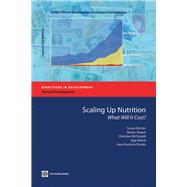
Note: Supplemental materials are not guaranteed with Rental or Used book purchases.
Purchase Benefits
What is included with this book?
| Foreword | p. ix |
| Acknowledgments | p. xi |
| About the Authors | p. xiii |
| Abbreviations | p. xv |
| Glossary | p. xvii |
| Executive Summary | p. xix |
| Introduction: Why Scale Up? | p. 1 |
| Why Scale Up Now? | p. 1 |
| The Objectives of This Report | p. 2 |
| Methodology: Estimating the Costs | p. 5 |
| The Scope of These Estimates | p. 5 |
| A Methodology Based on Experience | p. 9 |
| A Program of Proven Interventions | p. 12 |
| Some Assumptions about Coverage | p. 13 |
| Some Assumptions about Delivery of Services | p. 20 |
| What Will It Cost and What Are the Potential Benefits? | p. 25 |
| Estimated Costs | p. 25 |
| Supportive Policies and Programs: Conditional Cash Transfers | p. 34 |
| Links with Health Systems Strengthening | p. 36 |
| Expected Outcomes | p. 36 |
| Uncertainties and Sensitivity Analyses | p. 40 |
| Financing Options | p. 40 |
| Phasing the Scale-Up | p. 47 |
| A Phased Approach for the Scale-Up | p. 47 |
| Conclusions and Next Steps: Starting the Scale-Up | p. 51 |
| Meeting Participants | p. 57 |
| Rationale for Selected Nutrition Interventions and Comparisons with the 2008 Lancet Undernutrition Series | p. 61 |
| Appendix C | p. 65 |
| Pregnant Women | p. 66 |
| Mothers of Young Children | p. 67 |
| Pregnant Women in Areas with a Severe Shortage of Iodized Salt | p. 68 |
| Children 7-60 Months of Age | p. 69 |
| Malnourished Children 0-60 Months of Age | p. 69 |
| Entire Population | p. 71 |
| Program Costs for Complementary and Therapeutic Feeding Interventions | p. 73 |
| Treatment of Severe Acute Malnutrition | p. 73 |
| Treatment and Prevention of Moderate Malnutrition | p. 76 |
| Costing Strategy | p. 79 |
| References | p. 87 |
| Index | p. 93 |
| Figures | |
| A Two-Step Process for Scaling Up Direct Nutrition Interventions | p. xxv |
| Target Population Currently Covered by Nutrition Interventions and Planned Additional Coverage | p. 19 |
| Estimated Additional Costs for Scaling Up Nutrition Interventions to Full Coverage in the 36 Countries with the Highest Burden of Undernutrition | p. 33 |
| Current Spending and Additional Financing Needed to Scale Up Nutrition Interventions to Full Coverage in the 36 Countries with the Highest Burden of Undernutrition | p. 35 |
| A Two-Step Process for Scaling Up Direct Nutrition Interventions | p. 48 |
| Official Development Assistance Commitments for Health, HIV/AIDS, and Nutrition, 1995-2007 | p. 50 |
| Official Development Assistance Commitments for Nutrition and Emergency Food Aid, 1995-2007 | p. 51 |
| Share of Total Official Development Assistance for Health Commitments, by Selected Donors, 1998-2000 | p. 52 |
| Share of Total Official Development Assistance for Health Commitments, by Selected Donors, 2005-07 | p. 53 |
| Map | |
| 2.1 | p. 7 |
| Tables | |
| The 36 Countries with 90 Percent of the Global Burden of Stunting and an Additional 32 High-Burden Countries with Underweight or Stunting Rates Greater Than 20 Percent | p. 6 |
| Regional Cost Multipliers and Countries Covered | p. 11 |
| Nutrition Interventions, Target Populations, and Delivery Platforms Used to Estimate Financing Needs | p. 14 |
| Some Delivery Platforms Used in Programmatic Settings for Nutrition Interventions | p. 17 |
| Populations in Selected Demographic Groups in the 36 Countries with the Highest Burden of Undernutrition, by Region | p. 18 |
| Estimated Unit Costs for Nutrition Interventions | p. 21 |
| Estimated Annual Financing Needs for Scaling Up Nutrition Interventions to Full Coverage of Target Populations in the 36 Countries with the Highest Burden of Undernutrition, by Region | p. 26 |
| Estimated Benefits from Scaling Up Nutrition Interventions | p. 38 |
| Effects of Changing Five Assumptions about the Costs of Scaling Up Nutrition Interventions | p. 41 |
| Interventions Included/Excluded in This Costing Exercise | p. 62 |
| Proposed Interventions and Rationale for Inclusion/Exclusion | p. 64 |
| Cost per Case of Severe Acute Malnutrition Treated | p. 80 |
| Cost per Child 6-18 Months of Age Receiving Preventive Feeding for Moderate Malnutrition | p. 84 |
| Table of Contents provided by Ingram. All Rights Reserved. |
The New copy of this book will include any supplemental materials advertised. Please check the title of the book to determine if it should include any access cards, study guides, lab manuals, CDs, etc.
The Used, Rental and eBook copies of this book are not guaranteed to include any supplemental materials. Typically, only the book itself is included. This is true even if the title states it includes any access cards, study guides, lab manuals, CDs, etc.